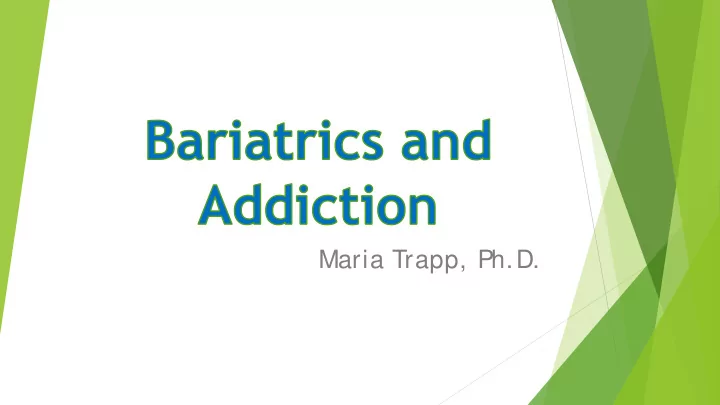

Maria Trapp, Ph.D.
BMI Classificat ion 18.5 to 24.9 Normal Weight 25 to 29.9 Overweight 30+ Obesity (including extreme obesity) 40+ Extreme Obesity
• 1 in 3 adults are Prevalence: 1-2 considered overweight • 1 in 3 are considered obese • 1 in 13 are considered extremely obese
Heredity Medications Computer Access to Healthy Food Television S ES Telephone S leep Habits S edentary Lifestyle S afety
Gallstones Cardiac Issues Mental Health Issues High Blood Pressure Joint Problems and Pain Diabetes Type 2
University of Oklahoma
----------------------------------------------------------------------------------------------------------
HIGHER RATES OF UICIDE 4 S
HIGHER RATES OF M 5 ALCOHOLIS
Addiction & Bariatric Population 6-7 Food Addiction Coping S trategies S ocial Reinforcement Food and fellowship • Wine and respect •
REFERENCES 1. National Institute of Diabetes and Digestive and Kidney Disease. Overweight and obesit y st at ist ics. 2017. Available at https:www.niddk.gov/ heath- information-statistics / overweight and obesity statistics. Accessed April 19, 2019. 2. Institute of health Metrics and Evaluation. The vast maj orit y of American adult s are overweight or obese, and weight is a growing problem among US children. May 28, 2014. Available at https:www.healthdata.org/ news-release/ vast- maj ority-americans. Accessed April 09, 2019. 3. American S ociety for metabolic and Bariatric S urgery. Lif e aft er Bariat ric S urgery. Available at https:/ / www.asmbs.org/ patients/ life- after-bariatric-surgery. Accessed April 09, 2019.
REFERENCES 4. Peterhansel C, Petroff D, Klinitzke A, Wagner B. Risk of completed suicide after bariatric surgery: a systematic review. Obesit y Reviews. 2013; 14(5): 369-382. 5. S padola C, Wagner EF , Dillon FR, Trepka MJ, Munoz NdlC, Messiah S E. Alcohol and drug use among post-operative bariatric patients: A systematic review of the emerging research and its implications. Alcoholism, Clinical and Experiment al research. 2015; 39(9): 1582- 1601. 6. Moorehead MK, Alexander CL. Transfer of addict ion and considerat ions f or prevent ive measures in bariat ric surgery: Part II. Presented at S urgery for the Foregut S ymposium. February 16, 2019. 7. Wadden TA, Faulconbridge LF , Jones-Corneille LS R, S arwer DB, Fabricatore AN, Graham Thomas J, Terence Wilson G. Binge eat ing disorder and t he out come of bariat ric surgery at one year: A prospect ive, observat ional st udy. 2011; 19(6): 1220-1228.
University of Oklahoma College of Medicine Department of Psychiatry and Behavioral S ciences
Recommend
More recommend